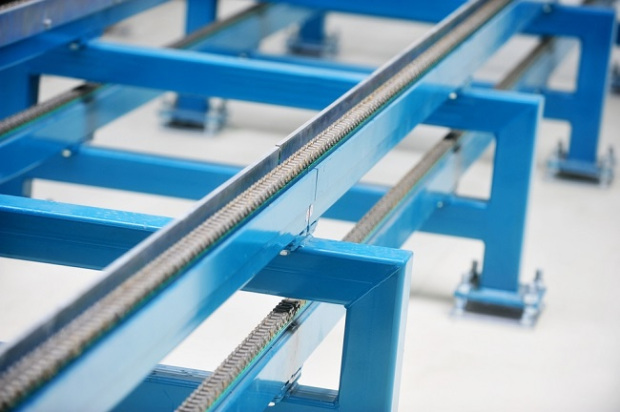Chain conveyors are used to transport items down production lines, assembly lines or around manufacturing and warehouse facilities. They use a continuous chain which is powered and has several pendants on which the materials are suspended and conveyed. Alternatively, the load is placed on a single or double stranded powered chain and moved around. Using a chain conveyor has several advantages as they are easy to install, have minimal maintenance and are flexible to use in any direction. They are ideal for transporting materials which have sturdy lower surfaces such as industrial containers, mined raw materials, grid boxes etc. as well as a myriad of applications in assembly and distribution.
 |
| Chain Conveyor |
Here are 5 industrial applications of using chain conveyors.
1. Transporting heavy loads: Chain conveyors are the best option to transport heavy loads across assembly lines as well as around facilities due to their extreme durability and reliability. They are the simplest type of conveyance systems and are easy to maintain and repair. The narrow width of the chain conveyor takes up minimal space and can cover large distances. This is useful in industries such as coal mining which require raw materials to be transported across large distances and narrow spaces. Flexible linkage systems with smooth running make them perfect for the transportation of goods. They also give even weight distribution and low elongation for secure transportation making it a popular conveyance method for timber harvesting, agricultural harvesting, and transport of manufacturing and construction materials
2. Special transport requirements: In special circumstances such as the conveyance of materials from high temperatures zones, other conveyor systems like belt conveyors or magnetic conveyors are quite ineffective. In industries such as bakery, textile, and chemical plants, chain conveyors made of resilient durable materials are the best solution.
3. Indexing and stop requirements: In manufacturing, assembly and finishing lines which require the conveyor to stop and start at regular or specified intervals of time using sensors, the chain conveyor are ideal. It is easy to couple with motion sensor technology and is perfect for other automated machines like robotic arms to interact with the load. This allows for accurate assemblies, easy paint, and coating applications, smooth finishing and additionally keep the product off the floor. Automotive industries and food processing plants have been using chain conveyors to take advantage of this feature for decades.
4. Varying speed needs Many times, the product is required to be moving at different speeds in different parts of the production or assembly line. When chain conveyors are simply fitted with a VFD (Variable Frequency Driver), it becomes extremely easy to control and adjust their speed.
5. In warehousing and storage: Chain conveyors are an easy method for distribution and transport across warehouses and storage facilities as they are flexible, take up less space, distribute the weight of the load evenly and have very high load capacity. Multiple conveyor chains and steel chain tracks for heavy loads, padded transfer chains for delicate glass and painted items and center mounted drives which allow the direction of transport to be reversed are optimum tools that can tackle every warehousing and storage need.
 |
| Chain Conveyor |
Chain conveyors are simple, versatile, durable and easy to maintain a method of conveyance which finds wide applications in several industries such as automotive, food processing, harvesting, mining, etc. in manufacturing, assembly, distributing and storage sectors. They are reliable and have high load capacities and are one of the most popular systems of conveyances for industrial applications.






0 Comments